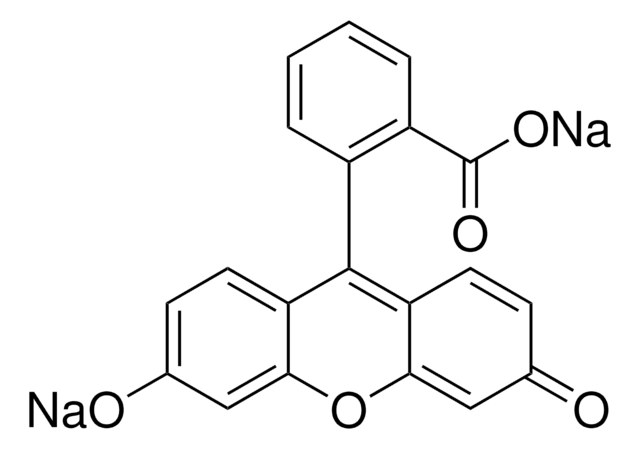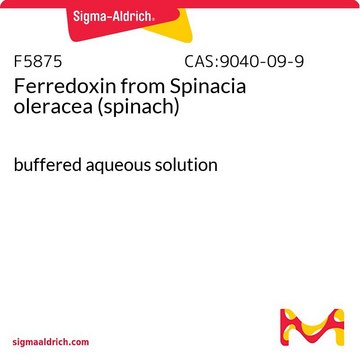Alle Fotos(1)
Wichtige Dokumente
61909
Atto Rho14 NHS Ester
BioReagent, suitable for fluorescence
Anmeldenzur Ansicht organisationsspezifischer und vertraglich vereinbarter Preise
Alle Fotos(1)
About This Item
UNSPSC-Code:
12352108
NACRES:
NA.32
Empfohlene Produkte
Produktlinie
BioReagent
Qualitätsniveau
Assay
≥90.0% (HPLC)
Form
solid
Hersteller/Markenname
ATTO-TEC GmbH
Kennzeichnungsgrad
≥90.0%
λ
in ethanol (with 0.1% trifluoroacetic acid)
UV-Absorption
λ: 624.0-630.0 nm Amax
Eignung
suitable for fluorescence
Lagertemp.
−20°C
Anwendung
Atto Rho14 NHS ester is a new rhodamine featuring a functionality for coupling to bio-molecules such as DNA, RNA or proteins. The label shows strong absorption and extraordinarily high fluorescence quantum yield. ATTO Rho14 is the brightest label available in this wavelength range. The dye exhibits an exceptionally high photostability. In common with most ATTO-labels, absorption and fluorescence are pH-independent in the range of pH 2 to 11, used in typical applications. The dye is moderately hydrophilic. After coupling to a substrate ATTO Rho14 carries a net electrical charge of +1.
Rechtliche Hinweise
This product is for Research use only. In case of intended commercialization, please contact the IP-holder (ATTO-TEC GmbH, Germany) for licensing.
Lagerklassenschlüssel
11 - Combustible Solids
Flammpunkt (°F)
Not applicable
Flammpunkt (°C)
Not applicable
Hier finden Sie alle aktuellen Versionen:
Besitzen Sie dieses Produkt bereits?
In der Dokumentenbibliothek finden Sie die Dokumentation zu den Produkten, die Sie kürzlich erworben haben.
Chao Ma et al.
Analytica chimica acta, 734, 69-78 (2012-06-19)
This article describes the design and preparation of a novel fluorescence resonance energy transfer (FRET)-based ratiometric sensor with the polymer nanoparticle as scaffold for detecting Hg(2+) in aqueous media. In this study, a fluorescent dye fluorescein isothiocyanate (FITC, served as
Yuan-Qiang Sun et al.
Angewandte Chemie (International ed. in English), 51(31), 7634-7636 (2012-06-08)
Probes to dye for: Rhodamine-inspired Si-pyronine, Si-rhodamine, Te-rhodamine, and Changsha NIR dyes have been developed recently. These dyes show fluorescence in the far-red to near-infrared region, while retaining the advantages of the original rhodamines, such as high fluorescence quantum yield
Raphael Alford et al.
Molecular imaging, 8(6), 341-354 (2009-12-17)
Fluorophores are potentially useful for in vivo cancer diagnosis. Using relatively inexpensive and portable equipment, optical imaging with fluorophores permits real-time detection of cancer. However, fluorophores can be toxic and must be investigated before they can be administered safely to
Jianghong Rao et al.
Current opinion in biotechnology, 18(1), 17-25 (2007-01-20)
In vivo fluorescence imaging uses a sensitive camera to detect fluorescence emission from fluorophores in whole-body living small animals. To overcome the photon attenuation in living tissue, fluorophores with long emission at the near-infrared (NIR) region are generally preferred, including
Chunbai He et al.
Biomaterials, 33(33), 8569-8578 (2012-08-22)
Polymeric nanoparticles have been widely applied to oral delivery of protein drugs, however, few studies focused on the systematical elucidation of the size-dependent oral absorption mechanism with well-defined polymeric nanoparticles. Rhodamine B labeled carboxylated chitosan grafted nanoparticles (RhB-CCNP) with different
Unser Team von Wissenschaftlern verfügt über Erfahrung in allen Forschungsbereichen einschließlich Life Science, Materialwissenschaften, chemischer Synthese, Chromatographie, Analytik und vielen mehr..
Setzen Sie sich mit dem technischen Dienst in Verbindung.




